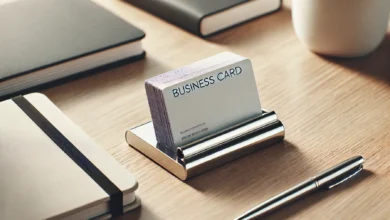Business Card Size

Business cards play a critical role in creating first impressions. Whether you’re networking, attending a conference, or simply promoting your business, the size and design of your business card can leave a lasting impression. One of the essential elements to consider when designing a card is its size. The correct dimensions can influence its practicality, professionalism, and readability. In this article, we’ll explore everything you need to know about business card sizes, from the standard dimensions to custom sizes, and why size matters.
What is the Standard Business Card Size?
Most businesses stick to a standard size for their cards. The standard business card size varies by country, but there is a general consistency.
Standard Business Card Size in Different Countries
Different regions have slightly different standard sizes for business cards. Here are the most common standards:
- United States and Canada: 3.5 x 2 inches (88.9 x 50.8 mm)
- United Kingdom and European Union: 3.3 x 2.1 inches (85 x 55 mm)
- Australia and New Zealand: 3.54 x 2.17 inches (90 x 55 mm)
- Japan: 3.58 x 2.17 inches (91 x 55 mm)
Why Stick to the Standard Size?
The standard size for business cards is widely used because it fits neatly into wallets, cardholders, and pockets. Its uniformity allows recipients to store and access them easily. Additionally, the standard size strikes a good balance between being noticeable and compact.
Custom Business Card Sizes
While the standard business card size is widely accepted, some brands choose to stand out with custom dimensions. Custom sizes can make a bold statement and enhance the memorability of your card.
Common Custom Sizes
If you decide to deviate from the standard size, here are a few popular custom options:
- Square Cards: Square business cards (2.5 x 2.5 inches) are modern and unique, offering a break from the traditional rectangle.
- Mini Cards: Mini cards (3 x 1.5 inches) are smaller than the standard, providing a minimalist and sleek design.
- Folded Cards: Folded business cards (3.5 x 4 inches folded to 3.5 x 2 inches) offer more space to include additional information like a portfolio or product offerings.
Advantages of Custom Business Card Sizes
Opting for a custom size has its advantages, especially if you’re in a creative industry or want to stand out from the crowd. A unique business card size can:
- Enhance memorability: A card with unique dimensions is more likely to be remembered.
- Reflect your brand: Custom sizes can better align with a brand’s personality, whether it’s sleek, quirky, or bold.
- Offer more space: Some sizes, like folded cards, offer extra room for additional information or visuals.
However, it’s essential to remember that custom sizes may not always be practical for storage in wallets or cardholders, and could even get misplaced.
Understanding Bleed, Trim, and Safe Zones
When designing your business card, size isn’t just about the final dimensions. Designers need to take into account the bleed, trim, and safe zones to ensure the card looks professional when printed.
Bleed Area
The bleed area refers to the outer margin beyond the final size of your business card. During printing, any designs or colors extending to the edges of the card should reach this area to ensure they are not cut off. Typically, the bleed area extends 0.125 inches (3.175 mm) beyond the card’s final dimensions.
Trim Line
The trim line is where the card will be cut after printing. This is the final size of the card, which for a standard U.S. card is 3.5 x 2 inches. Designers must ensure that important text or logos don’t extend beyond this line.
H3: Safe Zone
The safe zone is an inner margin within the trim line. To avoid text or logos being cut off during the trimming process, all essential elements should be kept within this area. A safe margin of at least 0.125 inches (3.175 mm) from the trim line is recommended.
H2: Digital vs. Physical Business Cards
The rise of digital technology has seen the emergence of digital business cards. While physical cards have a tangible presence, digital business cards are convenient for networking in the virtual space. However, size still matters, even in the digital world.
H3: Physical Business Cards
Physical cards give your contacts something tangible to hold and remember you by. They are more personal and can be handed out during events or meetings. Business card size plays a crucial role in the design and impression they leave.
Digital Business Cards
Digital business cards can be shared via email, QR code, or mobile apps. These cards don’t have physical size constraints but still need to fit neatly on a phone or computer screen. Their size should be optimized for mobile and web, ensuring all the information is easily readable.
Choosing the Right Business Card Size for Your Industry
Different industries may have different preferences when it comes to business card size. The right size for your business card can depend on your profession, branding, and the image you want to portray.
Creative Industries
For those in creative fields like graphic design, marketing, or photography, a custom-sized card can be an excellent opportunity to showcase your creativity. A square or folded business card might better reflect the originality and innovation of your work.
Corporate and Professional Services
In more traditional fields like finance, law, or consulting, the standard business card size is generally preferred. It reflects professionalism, order, and reliability. A custom size might come off as unorthodox or overly casual in these settings.
Best Practices for Designing Your Business Card
Once you’ve chosen the business card size, here are some best practices to ensure it leaves a lasting impression:
Keep It Simple
Simplicity is key when it comes to business cards. Avoid overloading the card with text or images. Stick to essential details like your name, job title, company, and contact information.
Choose Legible Fonts
Ensure that the fonts used on your card are easy to read. Avoid fonts that are too small or overly decorative. Sans-serif fonts are often a safe choice for professional cards.
Use High-Quality Materials
The material of your business card can also impact how it is perceived. Thicker cardstock feels more premium and durable. You can also experiment with finishes like matte, gloss, or foil to add a touch of elegance.
Consider Adding a QR Code
Incorporating a QR code on your business card can provide additional value by linking to your website, portfolio, or social media pages. It’s a tech-savvy way to offer more information without cluttering the card.
Conclusion
The size of your business card plays a significant role in how it is received by potential clients, partners, or employers. Whether you choose the standard dimensions or opt for a custom business card size, it’s essential to keep your target audience, branding, and practicality in mind. By understanding the standard dimensions, exploring custom options, and following design best practices, you can create a business card that leaves a lasting impression. Remember, the right business card is not just a networking tool – it’s a reflection of your professionalism and brand.




